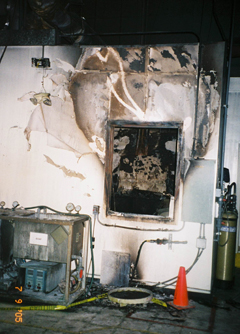ONLINE EXCLUSIVE: Building Teamwork to Deal with Disaster, Change
Lea Tonkin, editor in chief
 |
|
| M2 Global associates faced major cleanup tasks following a fire. |
Total team engagement brought out the best in associates at M2 Global Technology Ltd. when the San Antonio company suffered a fire in 2005. A defective heater caused a PVC ventilating hood to ignite, causing significant smoke damage throughout the manufacturing facility. Contamination affected the company’s high-precision machines, test equipment, tooling and clean room. This disaster temporarily shut down operations and could have caused the company to close its doors, said Doug Carlberg, president. The company’s product lines range from complex microwave radio frequency (RF) components to specialized prototypes and quick-turn production.
Carlberg credits M2 Global’s quick response to the disaster and its successful recovery to the company’s team-based management culture and assistance from many employees, who were allowed to enter the building after the fire marshal determined the cause of the blaze. Following disaster recovery plan guidelines developed several years earlier, associates scrubbed and refurbished work areas. Others disassembled, cleaned, and then reassembled most machines. Factory-authorized equipment technicians inspected machines before they were put back in production. Only one machine was scrapped.
The team prioritized customer orders, determining which were most urgently needed. They adapted operations to keep the company’s customer commitments, moving restored equipment to clean areas before they were put back into service. Thanks to 24/7 teamwork efforts, the plant regained 60 percent of its production capacity within three weeks, and then progressed to normal production flow within 90 days.
On the Move
This teamwork proved essential when M2 Global’s lease renewal contract almost doubled in cost several months later. The company moved to new quarters in San Antonio and achieved level production flow again, less than eight months after experiencing the fire.
 |
||
| Effective teamwork following a fire at the M2 Global plant in San Antonio enabled the facility to regain 60 percent of its production capacity within three weeks and normal production flow within 90 days. |
During a recent Association for Manufacturing Excellence (AME) “Driving Results Through People” event, Carlberg shared “lessons learned” from disaster recovery and plant relocation as well as dealing with market shifts. He noted that self-directed work teams (SDWT) gained maturity at M2 Global during the past few years. Expectations such as customer focus, cost and quality control, problem-solving, goal-setting, accountability, and performance evaluation contribute to SDWT performance.
Carlberg identified several M2 Global team roles:
- Leadership teams: They provide guidance and support and administer rewards.
- Area teams: Members run the business, improving quality and business performance.
- Special project teams: They solve problems (such as implementing a new piece of software) or redesign systems.
- Supplier/customer partnerships and alliances: Members “improve the white spaces” between organizations for more effective collaboration.
Handling disasters, disruptive market swings, and other unplanned developments may not be easy, but it can be accomplished more effectively through planning and teamwork, Carlberg said. All M2 Global employees received a copy of the book Who Moved My Cheese, sparking discussion and insights about dealing with change.
Teams can make transitions happen successfully, Carlberg said. “Get your teams engaged early and stay out of their way,” he counseled. Carlberg also suggested that leadership communicate and encourage understanding of four “boundary management” issues:
- Establish expectations
- Agree on objectives
- Set measurements
- Determine consequences.
If you want to hear more about this topic, AME will conduct another “Driving Results Through People” workshop April 4-5, 2012, in San Antonio; see ame.org for details.


